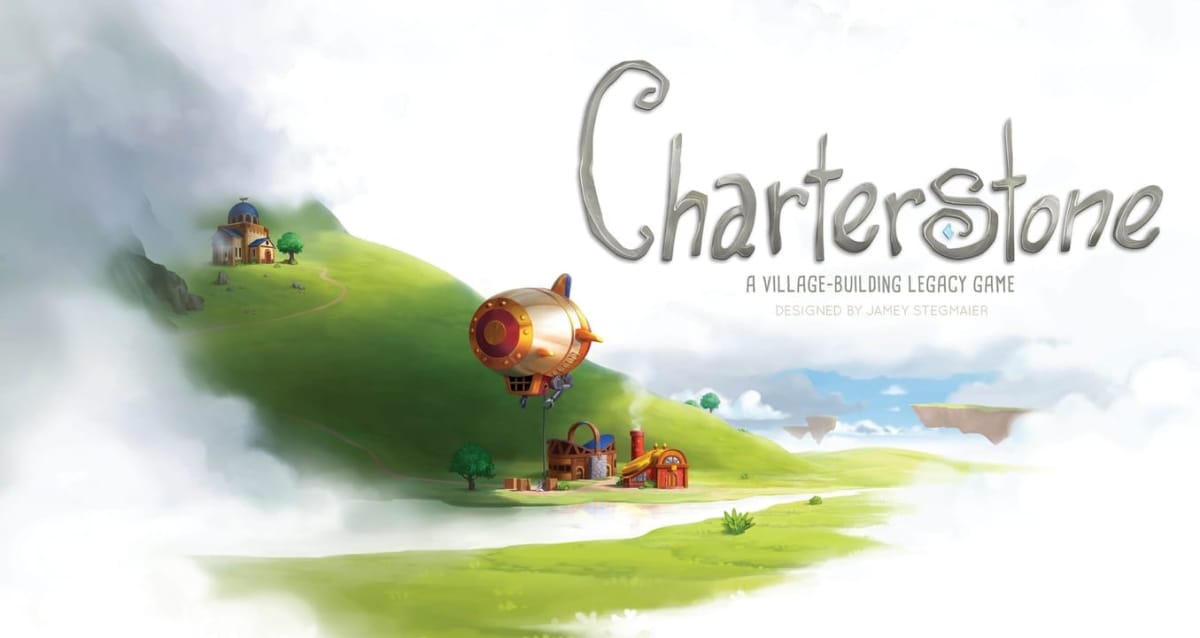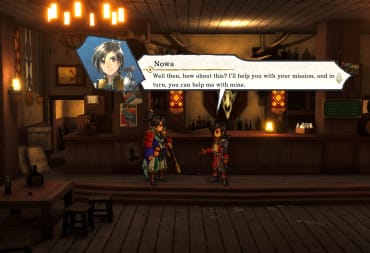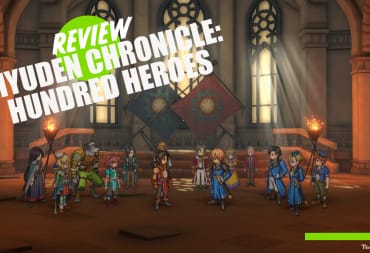First things first: this review is going to be almost entirely spoiler free. I've been going back and forth for a while about how to actually approach writing about Charterstone, and I think I've landed somewhere in the realm of explaining what the game feels like and my emotional journey as I played through the game without spoiling anything. I don't know if it's going to even be possible to get the points across about the game that I feel are important without talking about specifics, and I'm afraid that I'll veer into ramble-y metaphor that doesn't make sense to anyone other than myself if I'm not careful. I guess we'll find out if I can form a coherent review without directly referencing the specifics of the game, but discovery is a huge part of Charterstone, so in a way it's fitting that I try to discover if I can say something meaningful about the game in a way that preserves the element of discovery and surprise for anyone who has yet to play it. I normally take my own photos for reviews, but due to the nature of the game and how my copy has changed over time, I'm using pictures uploaded to Boardgamegeek.com directly by designer Jamey Stegmaier himself.
The first few games of Charterstone left me with a sinking feeling. I'd hyped the game up in my mind to incredible heights based on designer Jamey Stegmaier's previous body of work. This is the guy who designed two of my favorite worker placement games of all time, as well as Scythe, which is arguably one of the greatest boardgames of all time regardless of genre. To say that I expected another Stonemaier worker placement game to blow my socks off is an understatement, especially with the added legacy-hype that came along with the game. It's almost more fitting to say that I had an unspoken demand that Charterstone not only be incredible straight away but continue to wow and amaze me at every turn—but it didn't. It's a fair question to ask if the game would ever have been able to live up to the hype I'd built for it in my headspace, because the answer is almost assuredly "no," but I'd be dishonest if I tried to pretend that I wasn't amped to play this game and subsequently let down by my initial foray into it.
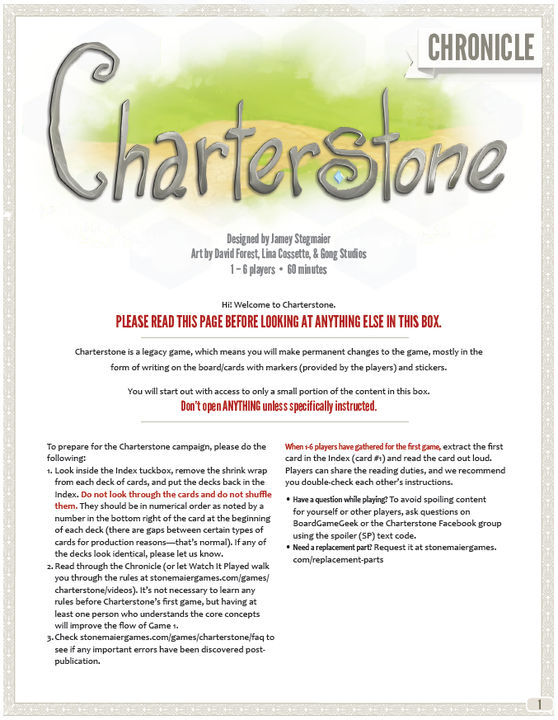
It's not that Charterstone does anything to dissuade you from learning or playing it. The game is designed to be played straight out of the box, without reading the rules ahead of time, and it almost entirely succeeds at that goal. Charterstone is new-player friendly, and the basics are straightforward enough that even younger players should be able to grasp many of the core concepts. The problem is that I expected a game as tight and fun as Viticulture as soon as I opened the box, and Charterstone wasn't either of those things. The game lasted too long (all of my games of Charterstone have been playing with 6 active players) and didn't have enough meat on its bones.
Before I go further into talking about my opinions and feelings game to game, I want to take a minute to talk about what Charterstone is. Charterstone is a legacy-style worker placement game where the players are working together to build a village, while simultaneously competing to win each game, and ultimately win the campaign. The campaign spans 12 plays, after which you are left with a copy of Charterstone that is unique to you and the people you played with, and the game can still be played as a standalone worker placement game once the campaign ends. That uniqueness comes from the legacy elements. The game changes permanently as you play it via stickers, new components, and even as players write on the board and the cards.
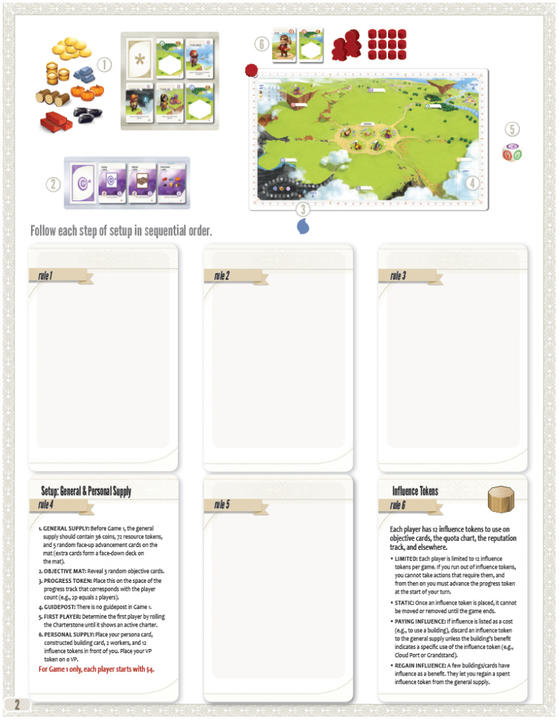
The biggest difference between Charterstone and the other legacy games that I've played is that the others (Gloomhaven, Pandemic Legacy, Risk Legacy, Castle Assault etc.) start with a fully realized game that is then changed, tweaked, and altered over time. Charterstone begins with only the barest of bones and doesn't become a fully realized game until after you've played it a few times. Charterstone isn't a game that you tweak, it's a game that forms in front of your eyes. It's a framework for discovery accompanied by a very light story that puts players in charge of how quickly, and in which directions, that framework will grow. That slow burn initially put my group and I off of the game, because we expected greatness from the get-go.
Now that we've established that my problems with Charterstone were as much a result of my expectations as the game itself, let's talk about how the game manages to set up and then subvert your expectations. The first five games of Charterstone set the game on a fairly clear track, pointing the players in one direction. It's in that first handful of plays that the game starts to fully form and flesh itself out. Once the game has its foundation solidly in place, it started to pull some really interesting parlor tricks that ramped up our enjoyment quite a bit. Game six and seven, and the surprise at the end of game eight, were better than the all of the previous games combined, and it made us excited to see what would happen next.
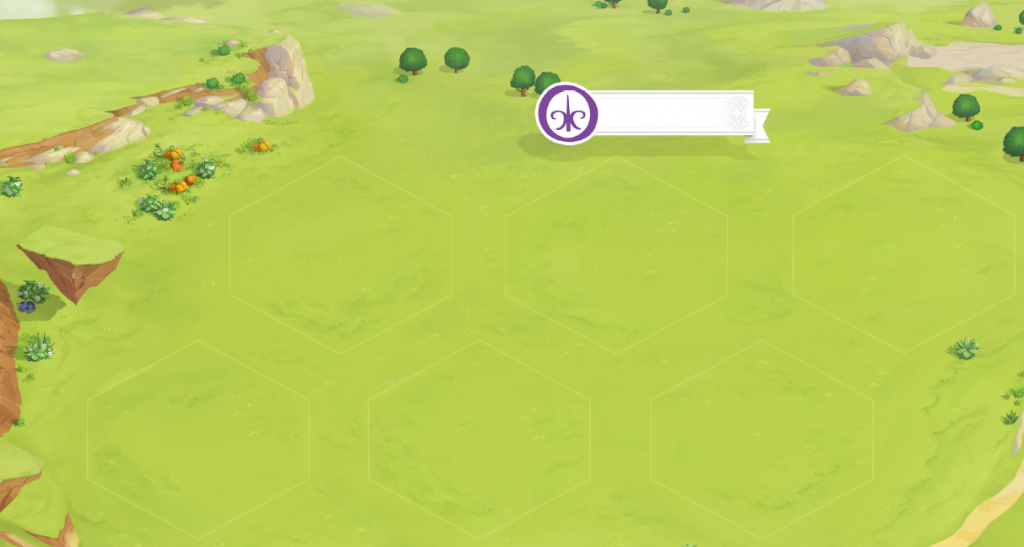
We've played every game of Charterstone with six active Charters (aka six players), and each game has clocked in at a minimum of 90 minutes, usually closer to 2 hours, so grinding through five games to get to the point where things started to feel exciting might be a bit much for some groups, especially since the campaign is only 12 games in total. There is plenty to do in those first five games, and players will be unlocking things and revealing new bits and bobs constantly, but there's not much crunch to it. It's fun and interesting to constantly open new things and stick new stickers on the board, but when that's the whole of the experience, it loses a bit of its luster. It's easy to see in hindsight, and I'm hoping that I get the point across now, that those first few games were us as players creating the game that we would start really appreciating at about the half way point of the campaign. This isn't a deep experience that you tweak as you play, it's an experience that the players collective build up game to game, which increases the game's depth with each subsequent play. Charterstone is a shared experience of creation and discovery as much as it is a game, and if you go into it with the understanding that you are crafting the game together, you'll start with a much more realistic expectation than we had.
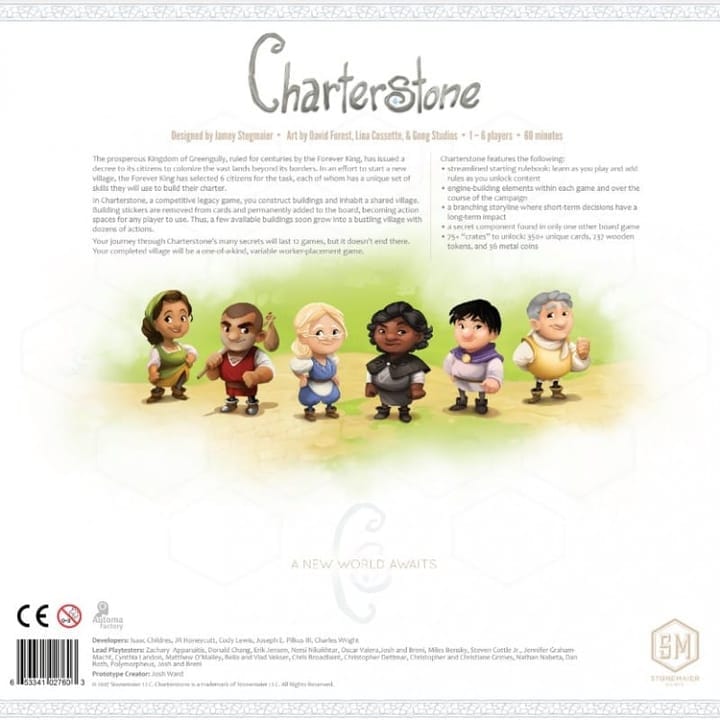
Speaking of unlockables, Charterstone has an embarrassment of riches if you like to reveal new cards, write on components, change rules and add new components to your games, especially in the first half of the campaign. There was constantly something new to see, some new rule that added a bit of spice to the game, or some odd bit that came completely out of left field and surprised us. The downside to having so much stuff is that the game ends up in a place that's somewhat bloated and fiddly. There are so many goodies that they can start to intimidate, especially if you aren't playing games of Charterstone in fairly rapid succession. Once most of the hidden bits have been revealed, it can be hard to track exactly what things do if you take a break from the game for a while. On a positive note, the rulebook is laid out in such a way that it's easy to find the sections that pertain to any individual cog in Charterstone's machine, and they are concise and well-written enough to bring you back up to speed at a glance.
Knowing what to expect should set you on the right path to having a good time with this game. It is an enjoyable experience, especially if you have your expectations in the right place, but it never quite reaches the lofty heights that we thought it would. Because so much of the experience is wrapped up in crafting the game together as a group, make sure you have a dedicated set of players in order to get the most out of Charterstone.
A note on replayability: Charterstone can be played as a standalone game after the campaign is finished, but there is also a recharge kit available (and the board is double sided) in case you decide that you want to experience the campaign again from start to finish. There are many either/or choices to be made during the campaign, and even though I haven't gone back to look at the choices that we didn't make, there are a few that seem major enough that they might significantly effect the way the game feels.
A note on player count: Charterstone can be played with 2 to 6 players, and comes with Automa rules in case you want to play with fewer than six yet still have more active Charters than the player count. I only played with 6 active Charters, but based on how well designed the Automa rules are in the other Stonemaier games, and based on my impression of reading the Automa rules here, I'd say that you shouldn't be put off Charterstone if you can't manage to find 6 players to commit to a 12 game campaign.
A note on “chrome”: Charterstone's production is almost uniformly excellent. The art style is cartoonish and inviting, and it fits the theme of the game perfectly. The bits that you unlock are all well made, and the rules are incredibly well written, especially considering the way the majority of them are added as you play. Even built piecemeal as they are the rules are coherent and easy to reference. The only exception comes in the form of some cards that have stickers on them that are still kept and used after the stickers have been peeled off. Those cards are very hard to keep pristine, and are noticeably thicker than the regular cards, so it can be obvious where those cards sit in the deck if they are bent at all. I don't think that it really effects the outcome of the games much to know where one of those cards sits in the deck, but they stood out like a sore thumb unless we were extremely careful when removing stickers from them.
The bottom line:
All told, Charterstone has been a very enjoyable experience for us. The rocky start at the beginning paved the way for pleasant surprises as the game matured, even if it never grew into something quite as tight nor as fun as its older siblings in the Stonemaier Games catalog. If you decide to pick up a copy then go into knowing that you will need to spend a few games developing it into a fleshed out experience. Charterstone awards persistence, and it offers up plenty of pleasant surprises, and so many unlocks that it teeters on the brink of being too fiddly for its own good, but it also becomes more fun as you play and collectively build it together with your friends. If you like legacy style games because you like to unlock hidden components, secrets and rules then Charterstone is going to be right up your alley, but if you want tight gameplay then know that you are going to have to put in some time and effort before you will really start to feel rewarded.
Get this game if:
You love unlocking components in legacy style games.
You are looking for a game that is as much, or more, about the experience and journey than it is the gameplay itself.
You have a consistent group of players who want to spend time building something together.
Avoid this game if:
You want a game that is tight and fully fleshed out from the beginning.
You want a game that has a deep, involved story.
You prefer games that play quickly, or only like to play a game 2 or 3 times before you move on to something else.
The copy of Charterstone used for this review was provided by Stonemaier Games.
Review Summary
Charterstone is a very good game, especially if you like legacy style unlockables, but it doesn't quite reach the lofty heights of other Jamey Stegmaier designs. The game does get better over time, but it's a slow build up to that point, so you will need to be patient for nearly half of the 12 game campaign before you really get into the meat of the game.
(Review Policy)Have a tip, or want to point out something we missed? Leave a Comment or e-mail us at tips@techraptor.net
